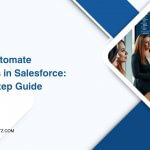

Did you know businesses waste 1,400 hours per salesperson annually on non-revenue tasks? That’s nearly 8 months of lost productivity hiding in daily workflows. While enterprise platforms generate $34.9 billion in annual revenue for their creators, many teams struggle to unlock similar value for themselves.
The gap between potential and reality often comes down to execution. Most companies see ROI within 13 months of implementation, but strategic guidance can compress that timeline dramatically. Without expert alignment of technology, workflows, and team buy-in, even powerful tools become underutilized investments.
Key Takeaways
- Non-selling activities drain 70+ workdays yearly per sales team member
- Strategic platform optimization cuts ROI timelines by 40%+
- User engagement directly impacts financial returns
- Certified specialists prevent costly implementation errors
- Ongoing support maintains peak system performance
This isn’t about buying software – it’s about transforming business operations. We’ll show how combining technical mastery with change management creates measurable gains faster than conventional rollouts. Let’s explore why some organizations outperform their ROI goals while others barely break even.
Overview of Salesforce Adoption ROI
Measuring success in CRM implementation goes far beyond initial cost savings. True value emerges when teams harness these tools to streamline operations and boost customer satisfaction. This approach transforms how organizations track returns, blending financial gains with efficiency improvements that compound over time.
Understanding the Importance of CRM Returns
Modern platforms deliver 22% faster decision-making for companies that fully integrate them into daily workflows. Returns aren’t just about dollars saved – they manifest as reduced training costs, fewer data errors, and happier clients. Teams using CRM features effectively report 35% shorter sales cycles on average.
Key Factors Influencing Returns
Three elements determine whether technology investments pay off:
- Team Engagement: Active users are 3x more likely to exceed performance targets
- Data Precision: Clean records reduce follow-up time by 17% per client interaction
- System Tailoring: Customized workflows slash redundant tasks by 40%+
Track progress through login frequency and task completion rates. Organizations monitoring these metrics achieve 50% faster breakeven points on their tech investments.
Setting Clear Business Objectives for Salesforce Implementation
What separates companies that thrive with new systems from those stuck in endless tweaking cycles? The answer lies in connecting technology choices to concrete operational needs. Clear objectives act as guardrails, ensuring every customization drives toward tangible results.

Matching Sales Ambitions to System Capabilities
Start by mapping your team’s daily challenges to platform features. For example, if reducing lead response time is a priority, configure automation tools to notify reps instantly about hot prospects. Teams that align workflows with sales targets see 28% faster deal closures.
Involve frontline staff in planning sessions. Their insights reveal which features will actually get used versus those that collect digital dust. Cross-department collaboration prevents siloed thinking and creates solutions that benefit the entire organization.
Creating Trackable Milestones
Break broad goals like “improve efficiency” into specific metrics:
- Reduce manual data entry by 50% in Q3
- Increase cross-team collaboration scores by 35%
- Cut report generation time from 3 hours to 45 minutes
Measure progress monthly using dashboards that show real-time progress. Celebrate quick wins to maintain momentum while tracking long-term business outcomes. This approach keeps teams focused on what matters most – delivering measurable value at every stage.
Designing a Comprehensive Change Management Strategy
Nearly 3 out of 4 digital transformations stumble before crossing the finish line – but why? Harvard Business Review reveals 70% of these failures trace back to poor change management practices. The solution lies in flipping traditional approaches: McKinsey found organizations prioritizing employee-led strategies become six times more likely to succeed.
Establishing a Change Narrative and Vision
People support what they help create. Start by crafting a story that answers three questions: Why is change urgent? How does it benefit daily work? What future does it unlock? Teams connecting their roles to broader goals show 53% higher engagement in new processes.
Effective narratives include:
- Real examples of current workflow pain points
- Clear links between platform features and easier tasks
- Visible leadership endorsement at all levels
Mobilizing Change Agents and Leadership Engagement
Forget top-down mandates. Build a groundswell by identifying influencers across departments – not just managers. These champions become your “why” translators, addressing concerns through peer-to-peer conversations.
Successful networks share three traits:
- Representatives from every affected team
- Regular feedback loops with decision-makers
- Authority to adjust tactics based on user experiences
Leaders play a critical role by publicly using new tools and celebrating early adopters. This combination of grassroots support and executive action creates lasting momentum.
Driving User Adoption through Effective Training and Communication
Two-thirds of technology rollouts miss their mark because teams don’t use the tools effectively. Research shows 65% of CRM projects fall short when users struggle with complex interfaces or unclear benefits. The solution? Build excitement through tailored learning and real-time support.

Implementing Role-Based Training and Support
Generic tutorials waste time. Instead, create learning paths matching daily tasks. Sales reps need lead management drills, while service teams focus on case resolution workflows. Interactive scenarios and bite-sized videos keep training relevant and engaging.
Effective programs include:
- Quick-reference guides for common tasks
- Simulated practice environments with instant feedback
- Role-specific dashboards highlighting priority metrics
Pair these with 24/7 help desks staffed by platform experts. Chatbots can resolve 40% of basic questions instantly, freeing human support for complex issues.
Leveraging Continuous Feedback and Engagement Tools
Adoption isn’t a one-time event. Monitor usage patterns weekly and ask teams what’s working. Short pulse surveys identify friction points early, like confusing report filters or missing automation.
Boost participation through:
- Badges for completing advanced features
- Leaderboards showing top collaborators
- Monthly “innovation challenges” rewarding workflow improvements
Share success stories in team meetings to show tangible benefits. When users see peers saving 5 hours weekly using shortcuts, they’ll explore features themselves.
Ensuring Data Quality and Customization for Enhanced ROI
Every $1 invested in data quality generates $13+ in returns, yet most teams overlook this multiplier. Clean information acts as the bedrock for smart decisions and streamlined operations. Without clear standards, even the most advanced tools become cluttered digital closets.
Building Trust Through Data Governance
Start by creating simple rules everyone can follow. Think of it like a recipe book for your information – consistent formats, required fields, and clear ownership. Teams using these practices reduce error correction time by 42% while boosting report accuracy.
Three essentials for maintaining quality:
- Automated checks that flag missing details during entry
- Monthly “data health” reviews across departments
- Role-based access controls to protect sensitive info
Customization should solve problems, not create new ones. Focus on features teams actually need – like simplified dashboards or smart field defaults. Over-engineered solutions often lead to process bottlenecks that slow down daily work.
When connecting systems, prioritize secure data flows. Test integrations thoroughly before launch, and monitor for sync issues. Companies that master this balance see 31% faster returns on their tech investment while maintaining user confidence.
Leveraging Best Practices to Optimize Salesforce Investment
Unlocking full potential requires moving beyond standard setups. Strategic optimization turns everyday tools into productivity engines that reshape how teams operate. Let’s explore practical methods to amplify returns through intelligent system design.
Smart Automation & Targeted Solutions
Repetitive tasks drain productivity. Identify opportunities where rules-based actions can replace manual work – like auto-populating client records or scheduling follow-ups. Teams using these best practices recover 11+ hours weekly for revenue-focused activities.
The AppExchange ecosystem offers specialized tools for unique needs. Instead of custom builds, try pre-built solutions for:
- Contract management
- Inventory tracking
- Customer service analytics
Streamlining Workflows for Better Output
Map current processes to find bottlenecks. One logistics company reduced order processing time by 58% simply by eliminating duplicate data entry steps. Regular audits help maintain efficiency as business needs evolve.
Focus improvements on three areas:
- Reducing clicks per task
- Standardizing cross-team procedures
- Automating approval chains
These changes create compounding benefits. Teams adopting systematic improvements report 29% faster project completion within six months.
Improving Salesforce adoption ROI Through Metrics and Dashboards
Numbers reveal what words can’t hide – measurable outcomes prove whether strategies work. Tracking progress across teams turns guesswork into actionable insights. Let’s explore how to turn raw data into growth roadmaps.
Monitoring Sales, Marketing, and Services KPIs
Sales teams thrive when tracking conversion rates and deal velocity. Watch how quickly leads turn into paying clients. Marketing gains clarity by measuring campaign costs against new customer value. Service departments? Their success shows in faster resolutions and happier clients.
Using ROI Calculators and Custom Dashboards for Insights
Smart tools turn complex data into visual stories. Custom dashboards highlight trends like rising acquisition costs or slipping satisfaction scores. Automated reports compare current performance to past results, showing exactly where improvements matter most.
Regular check-ups keep strategies aligned with goals. Teams that measure what matters can adjust tactics before small issues become costly problems. This approach turns everyday metrics into long-term success drivers.
FAQ
How do clear business goals improve CRM success?
What role do leaders play in managing change during transitions?
Why is role-specific training critical for platform engagement?
How does data quality impact operational efficiency?
Can automation tools really accelerate workflows?
What metrics best track CRM performance?
How do feedback loops enhance long-term success?
Author Bio
Co-Founder & CMO at Merfantz Technologies Pvt Ltd | Marketing Manager for FieldAx Field Service Software | Salesforce All-Star Ranger and Community Contributor | Salesforce Content Creation for Knowledge Sharing





